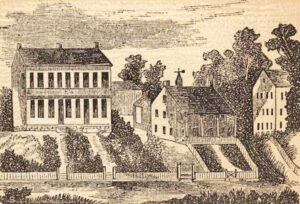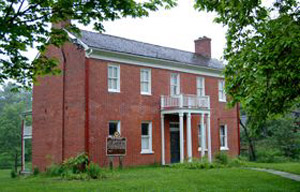Thomas Johnson was a Methodist minister who founded the Shawnee Methodist Mission in Kansas.
Johnson was born in Virginia on July 11, 1802. His parents were poor, and he was thrown to his resources almost from boyhood. At a comparatively early age, he went to Missouri, where he prepared himself for the Methodist Ministry and filled several positions under the auspices of the Missouri conference.
In 1829, he married Sarah T. Davis of Clarksville, Missouri, with whom he would have 14 children, though most of them died very young.
In 1830, he began a mission in a log structure near the Kansas River in present-day Kansas City, Kansas. The mission served both the Shawnee and Delaware tribes until 1839. At that time, the Reverend Johnson needed a larger facility and felt that if they moved the mission and built a new school for the Indians, it would serve more tribes. In 1839, the mission was relocated to a site on the Santa Fe Trail in present-day Fairway, Kansas.
The first building was completed in October 1839 and was utilized for classrooms and living quarters for teachers. Another 15 buildings would be constructed in the following years. Children from many tribes lived on the mission to learn school subjects and manual or domestic skills. The mission became a noted stopping point for explorers and travelers on the Santa Fe and Oregon Trails.
After serving for about 12 years, his health was failing, and he went to Cincinnati, Ohio, for medical treatment. Afterward, he lived near Fayette, Missouri, until his health was fully regained. In the fall of 1847, he returned to work at the Shawnee Mission and remained there until after the Kansas-Nebraska Bill was passed in 1854.
Johnson was a slaveholder who sided firmly with the pro-slavery group. This was during a period in Kansas Territory known as Bleeding Kansas, when it was unclear whether residents would vote to allow slavery in the territory.
On March 30, 1855, he was elected a member of the Territorial Council from the First District. Shawnee Mission was designated as the territorial capital from 1855 to 1856. These politicians and sessions would later become known as the Bogus Legislature.
In 1858, Reverend Thomas Johnson turned the school over to his oldest son, Alexander. Retiring from mission work, he bought a home about two miles from Westport, Missouri.
Though Johnson was pro-Southern in sympathy, he signed a Unionist pledge when the Civil War broke out. This caused him to become a marked man by the guerrillas and bushwhackers.
On the night of January 2, 1865, he was killed by a gang of armed men at his home. The bullet that ended his life passed through the door while he fastened it to keep out the marauders.
He was buried in the Shawnee Methodist Mission cemetery, along with several members of his family. The old cemetery stands three blocks east of Mission Road on Shawnee Mission Parkway. Johnson County, Kansas, was named for him.
Shawnee Mission continued to be operated by his son, Alexander, until it closed in 1862. During the Civil War, the site and its buildings were utilized as a camp for Union soldiers.
Today, the three largest brick structures, which once served as living quarters and classrooms of the Shawnee Mission, are National Historic Landmarks. The Kansas Historical Society administers it. Today, the historic site is a museum featuring exhibits on Kansas Indians, agents, and missionaries, Kansas settlement, overland trails, the Kansas-Missouri Border War, and the Civil War.
©Kathy Alexander/Legends of Kansas, updated August 2025.
Also See:
Shawnee Methodist Mission, Kansas
Sources:
Blackmar, Frank W.; Kansas: A Cyclopedia of State History, Vol I; Standard Publishing Company, Chicago, IL 1912.
Kansas City Public Library
Wikipedia



